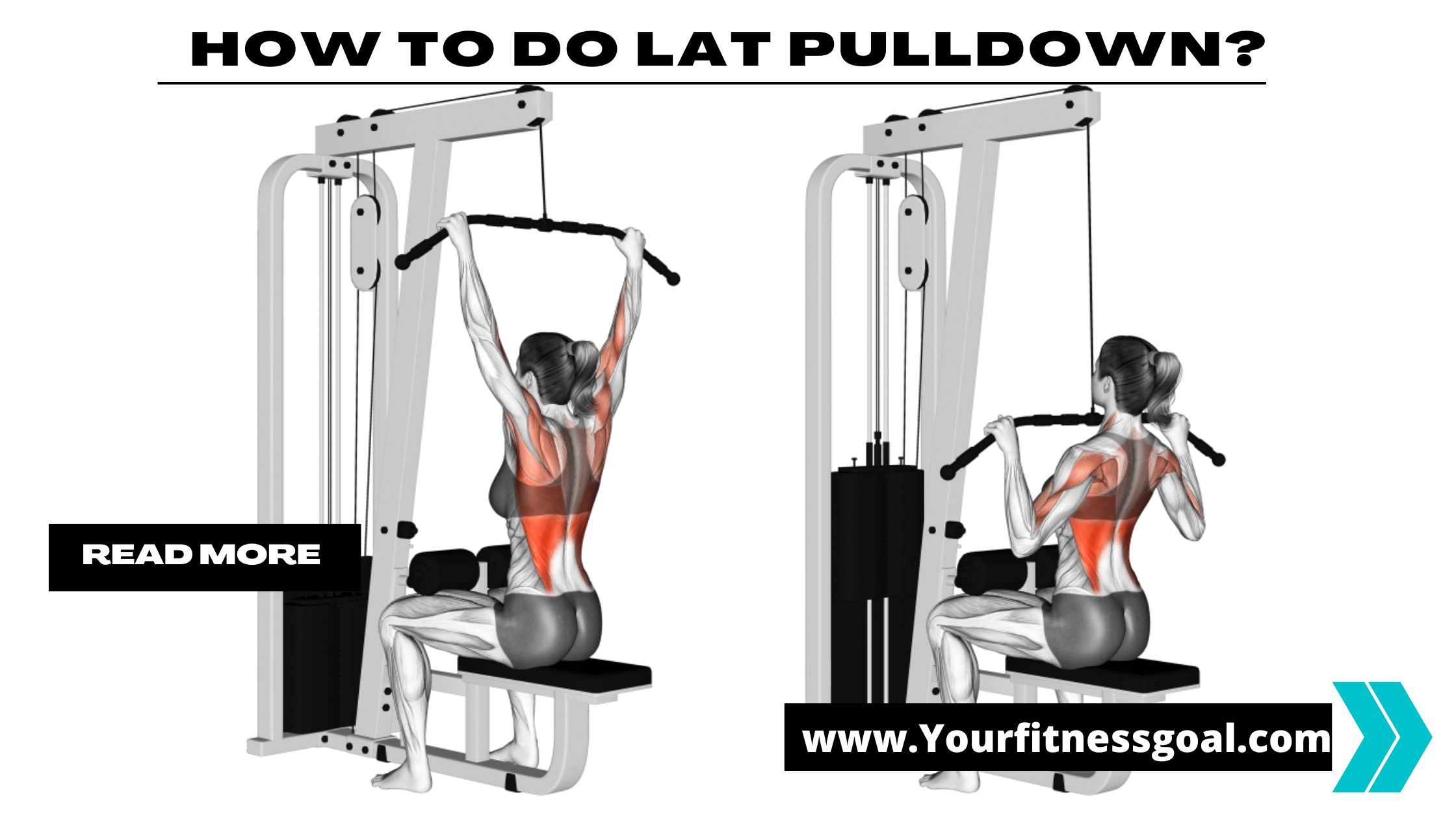Target: shoulder, back
Required equipment: Cable Machine, Lightweight, or Resistance Bands
Flat: beginner
Lat Pulldown exercises work your back muscles and are performed on a bench (usually a plate) with adjustable resistance.
While seated, pull the hanging bar toward you and raise it to chin level, then release the bar with control and he repeats once. This lateral pull down exercise can be done as part of your upper body strength training.
How to do a Lat pulldown
Sit comfortably in the folding seat with your feet flat on the floor. Check your bar height. You may need to adjust the bar height by shortening or lengthening the chains or cables that support the bar or seat height. Get a fitness trainer to help you with this if you want.
The bar should be high enough so that your outstretched arms can comfortably grip the bar without having to stand up fully but still allow your arms to be straight and have a full range of motion. Yes. If your station has thigh pads, adjust them so that your thighs fit snugly under the pads. This helps when you’re struggling at the bar.
- Grasp the bar with an overhand grip and a wide grip with knuckles up. Other positions and grips are possible but start with this standard position.
- Pull the bar down to chin height. Exhale in a downward motion. A little downshifting is fine but keeps your upper body still. Keep your feet flat on the floor and tighten your abs as you pull. The end of the movement is a position where the elbow cannot be lowered without moving backward. Stop at this point and don’t let it drop further.
- Squeeze your shoulder blades together while keeping your shoulders straight.
- From the down position with the bar close to your chin, slowly return to the starting position while controlling the gradual rise of the bar. Avoid hitting the weight plate.
- Continue until you have completed 8-12 repetitions in one set. Take a break, then complete your writing program.
Benefits of Lat Pulldowns
This exercise targets the latissimus dorsi muscle, better known as the lats. This is the muscle located just below the armpit and extending down the back and down. Isolating your back muscles with this exercise allows you to focus on your back muscles without straining your biceps and triceps. It’s important to target your back muscles to support proper posture and facilitate pulling movements such as: For example, opening a door, starting a lawn mower, swimming, or doing pull-ups. Strong lats may even help relieve some types of back pain.
Other variations of the lat pulldown
This exercise can be done in many ways to suit your skill level and goals.
Lightweight weights or bands for beginners
Beginners may want to start with light weights or bands to ensure they use the proper form. increase.
Alternate handle
Try wider and narrower underhand or overhand grips to target specific muscle groups. With a medium-distance grip, with your forearms upright and your hands shoulder-width apart, work your biceps and mid-back. Wider grips engage more back muscles, while narrower grip pulldowns emphasize forearm muscles.
Straight arm pulldown
Straight His Arm His pulldown (usually while standing), which requires the elbow to remain nearly fully extended, hits the muscle at the back of the upper arm known as the triceps.
Reverse the grip
Switching the grip to underhand with knuckles down and palms down puts more stress on the front muscle of the upper arm known as the biceps.
You can reverse your grip on any position on the bar – wide, middle or narrow.
Also read, ways to crack your back
Common mistakes
Try to avoid these mistakes to get the most out of this exercise and avoid strain and injury.
Round your back
Sit upright and pull the bar down while keeping your chest up. Maintaining a neutral spine can help protect your lower back from injury. use the forearm
Make sure your forearms don’t pull the bar down. Allow the bar to come off your back. Activate your lats by pulling them down from your armpits.
Hold the bar too long
Grip the bar just outside your shoulders, but not too wide, especially if you’re a beginner. As you lower the bar, keep your elbows down and out to the sides.
Drag down too much
Stop in the elbow-back position and continue to pull the cable down. Retraction of the elbow puts undue stress on the shoulder joint. The bar should be lowered to the chin or just below it.
Use the momentum
As with most weight exercises, pull downs are slow and controlled. Doing it quickly consumes momentum and reduces the use of the target muscle.
Safety and precautions
Lat pull downs behind the neck are not recommended for safety reasons. If you have wrist, elbow, or shoulder problems, talk to your doctor or physical therapist to see if this exercise is right for you. Stop this exercise if you experience pain or excessive stress on the shoulder joint.
The number of repetitions you perform in your workout depends on the weights you use, your experience level, and your strength.
FAQ –
1. What Muscles Do Lat Pulldowns Work?
Ans. The Lat pulldown works the muscles in your back, especially the large, flattened latissimus dorsi, commonly known as the “lat”.
2. Lat pulldowns or pullups, which is better?
Ans. Lat pulldowns are a great alternative to pullups if you’re still looking to build strength. Pull-ups tend to be better at building strength, but lat pull-downs are more versatile because the weight can be adjusted. Regardless, both exercises effectively target the muscles in your back.
3. Are Lat pulldowns shoulder or back?
Ans. The Lat pulldown is an exercise that works your back muscles. The latissimus dorsi is a large back muscle that runs from the sides of your back to your buttocks.
4. Does Grip Affect Lat Pulldowns?
Ans. The grip is less important when doing Lat pulldowns. You can choose between wide and narrow grips. Both work the lats. A wider grip can target your lats more, while a narrower grip activates your rhomboids and trapezius muscles.
Sources –
- Snyder BJ, Leech JR. Voluntary increase in latissimus dorsi muscle activity during the lat pull-down following expert instruction. J Strength Cond Res. 2009;23(8):2204-9. doi:10.1519/JSC.0b013e3181bb7213
- Andersen V, Fimland MS, Wiik E, Skoglund A, Saeterbakken AH. Effects of grip width on muscle strength and activation in the lat pull-down. J Strength Cond Res. 2014;28(4):1135-1142. doi:10.1097/JSC.0000000000000232

Hey, y’all! I’m Akshay!
I’m SO excited you’re here! I’m super passionate about nutrition and specialize in teaching others how to lose weight through healthy, low-carb eating along with Yoga and exercises. Here at Yourfitnessgoal, we believe in quality over quantity and that diet is EVERYTHING when it comes to your health and well-being. In short, we believe in a Fit and healthy lifestyle.

